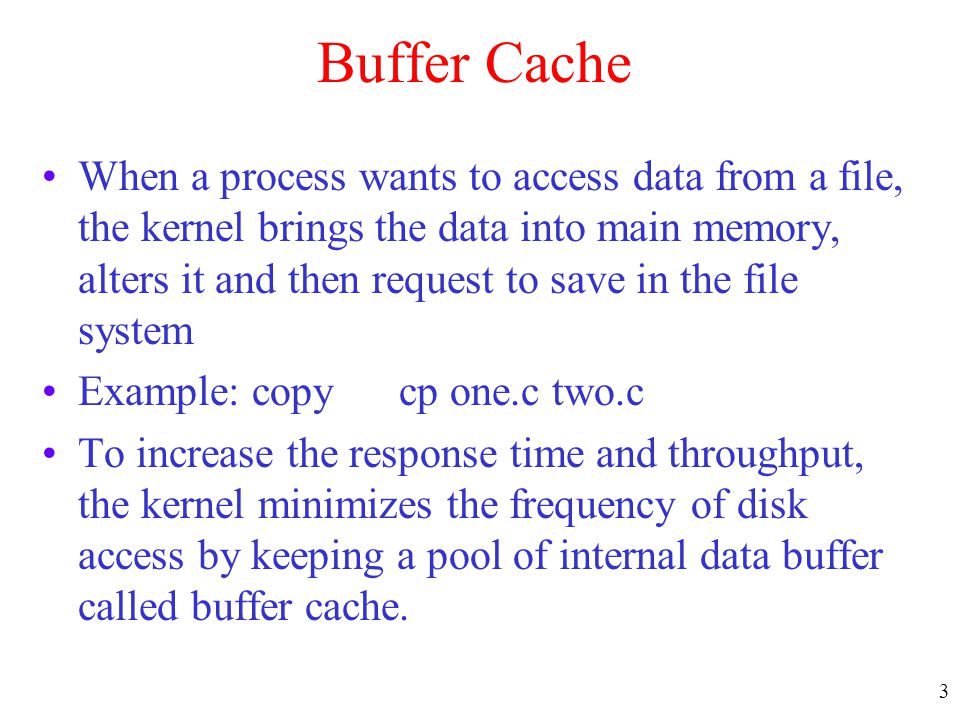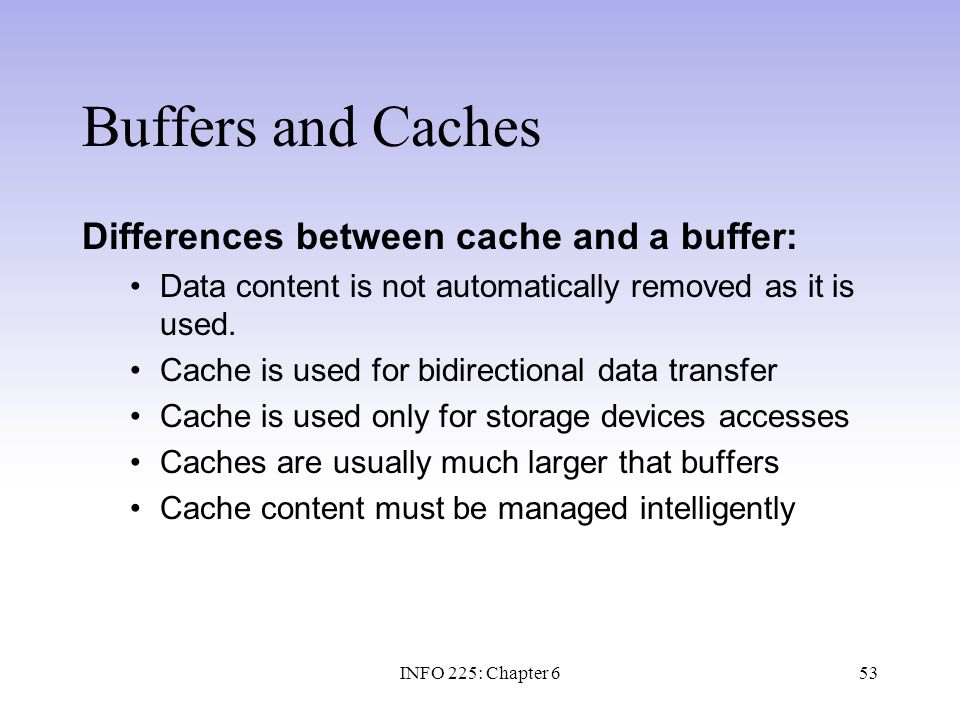Explain the Difference Between a Buffer and a Cache
Caching is the process of storing data in a separate place called the cache such that they could be accessed faster if the same data is requested in the future. RAM vs Cache Memory.

Chapter 3 Buffer Cache Topics Unix System Architecture Buffer Cache Ppt Video Online Download
Cache memory is within CPU it works like a buffer in Computer system.

. Like the operating system as a whole the buffer caches fun- damental purpose is to enable safe cooperation between processes. This question can be a bit complicated to answer unless you understand the difference between Virtual memory used memory and bufferscache. Buffers is the size of in-memory block IO buffers.
Amount of memory used to cache data by the kernel in kilobytes. Buffers may also include system buffers temporarily allocated for the running application. A buffer can only be part of ram.
RAM Random Access Memory is the primary memory. Like the operating system as a whole the buffer caches fun- damental purpose is to enable safe cooperation between processes. Least Recently Used LRU.
Page and Buffer Cache. It reduces the access time to fetch data from the main memory. 4 to 16 cache lines.
The data which is to be used many times results in wastage of time if it is in hard disk but storing the data in cache reduces this time wastage. Buffers are temporary storage for raw disk blocks that is cache data write to disks usually not very large about. Cached is the size of the page cache.
Typically buffering is required when there is difference between the speeds in which the data is received and data is processed. All user processes concurrently connected to the instance share access to the database buffer cache. Cache is a smaller and fastest memory component in the computer.
Difference Between RAM and Cache Memory. Replacement algorithms for associative set associative mapping. -Each block only maps to one line.
Difference between Spooling and Buffering Computers Web Services Computer Network In context of performance of a computer main factor is of multitasking ie how processes are divided and performed by the CPU between different input output sub systems. Please could someone explain the difference. 8 rows CACHE.
Caching is storing data in a separate disk very fast speed disk. Assuming you already know the definitions of Buffer and Cache. Key Differences Between Buffering and Caching in OS.
In SQL Server the buffer cache is the memory that allows you to query frequently accessed data quickly. Buffers is largely irrelevant. Replacement algorithm for direct mapping.
The man page for sar shows the following definitions. The database buffer cache holds copies of data blocks read from the data files. The free command also distinguishes between buffers and cached.
Between direct mapped L1 cache and next level of memory. The key difference between buffer and cache is that buffer memory is used to cope up with the different speed between sender and receiver of the data stream whereas the cache is a memory which stores the data so that access speed can be fastened for repeatedly used data. Cache is a page cache for reading files from disk which is used to cache data read from files.
Cache is optional space. Buffer is used to compensate for difference in speed between two processes that. Buffers are mandatory space.
July 2 2011 Posted by Indika. What is the major difference between the buffer cache and the page cache. When its full older or less frequently used data pages are moved to the hard disk.
It stores data in KB and recent activities that are done by CPU. CPU always first look for data in cache memory and if not present in the cache then get from the RAM. Why is buffer cache memory needed.
Setting up a link between pages and buffers serves little purpose if there are. The term data block is used to describe a block containing table data index data clustered data and so on. Basically it is a block that contains data.
Buffer is used to compensate for difference in speed between two processes that exchange or use data. The buffer cache is communicated to a Database Writer process DBW0 the it says to you that maybe an result of an insert command will be stored in data files it is the common files where your data is stored and from the other hand you have the Redo Log buffer that is communicated with the Log Writer process LGWR and it write into redo log files I. I think the difference arises because of the fact that the OS works in 4KB chunks but files are not necessarily aligned on 4KB boundaries on the media.
Reading a block from the buffer cache is less costly in terms of time than reading it from the disk. Cached is the size of the Linux page cache minus the memory in the swap cache which is represented by SwapCached thus the total page cache size is Cached SwapCached. I was looking for more clear description about buffer and i found in Professional Linux Kernel Architecture 2008.
The purpose of the buffer cache is to minimize physical io. RAM and cache memory are two members in this memory hierarchy. Most of the time you observe the output of free command free memory section will be low value but comparatively bufferscache value would be higher.
Here buffering is used. A cache is something that has been read from the disk and stored for later use. 1Cache is a high-speed storage area while a buffer is a normal storage area on ram for temporary storage.
Amount of memory used as buffers by the kernel in kilobytes. The buffer cache serializes access to the disk blocks just as locks serialize access to in- memory data structures. This way the.
A fully associative cache. Memory of a computer is organized in to a hierarchy and they are organized considering the time taken to access them cost and capacity. When data is written to or read from a SQL Server database the buffer manager copies it into the buffer cache aka the buffer pool.
A buffer is something that has yet to be written to disk. I think cache holds chunks of file that are 4KB aligned within the file while buffers hold chunks of the filesystem that are 4KB aligned in the filesystem but not in a specific file. When a block is read by Oracle it places this block into the buffer cache because there is a chance that this block is needed again.
2Cache is made from static ram which is faster than the slower dynamic ram used for a buffer.


Comments
Post a Comment